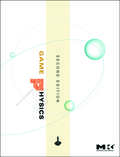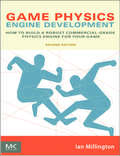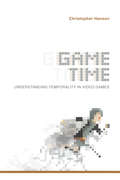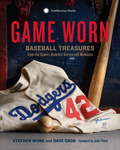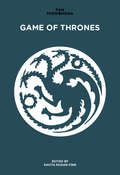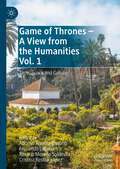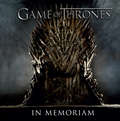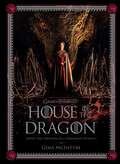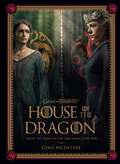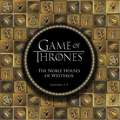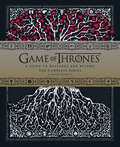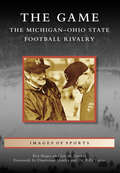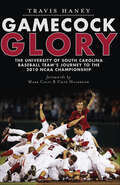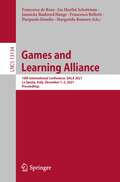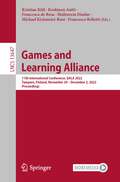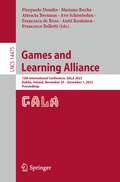- Table View
- List View
Game Physics
by David H. EberlyCreate physically realistic 3D Graphics environments with this introduction to the ideas and techniques behind the process. Author David H. Eberly includes simulations to introduce the key problems involved and then gradually reveals the mathematical and physical concepts needed to solve them.
Game Physics Cookbook
by Gabor SzauerDiscover over 100 easy-to-follow recipes to help you implement efficient game physics and collision detection in your games About This Book • Get a comprehensive coverage of techniques to create high performance collision detection in games • Learn the core mathematics concepts and physics involved in depicting collision detection for your games • Get a hands-on experience of building a rigid body physics engine Who This Book Is For This book is for beginner to intermediate game developers. You don't need to have a formal education in games—you can be a hobbyist or indie developer who started making games with Unity 3D. What You Will Learn • Implement fundamental maths so you can develop solid game physics • Use matrices to encode linear transformations • Know how to check geometric primitives for collisions • Build a Physics engine that can create realistic rigid body behavior • Understand advanced techniques, including the Separating Axis Theorem • Create physically accurate collision reactions • Explore spatial partitioning as an acceleration structure for collisions • Resolve rigid body collisions between primitive shapes In Detail Physics is really important for game programmers who want to add realism and functionality to their games. Collision detection in particular is a problem that affects all game developers, regardless of the platform, engine, or toolkit they use. This book will teach you the concepts and formulas behind collision detection. You will also be taught how to build a simple physics engine, where Rigid Body physics is the main focus, and learn about intersection algorithms for primitive shapes. You'll begin by building a strong foundation in mathematics that will be used throughout the book. We'll guide you through implementing 2D and 3D primitives and show you how to perform effective collision tests for them. We then pivot to one of the harder areas of game development—collision detection and resolution. Further on, you will learn what a Physics engine is, how to set up a game window, and how to implement rendering. We'll explore advanced physics topics such as constraint solving. You'll also find out how to implement a rudimentary physics engine, which you can use to build an Angry Birds type of game or a more advanced game. By the end of the book, you will have implemented all primitive and some advanced collision tests, and you will be able to read on geometry and linear Algebra formulas to take forward to your own games! Style and approach Gain the necessary skills needed to build a Physics engine for your games through practical recipes, in an easy-to-read manner. Every topic explained in the book has clear, easy to understand code accompanying it.
Game Physics Cookbook: Discover over 100 easy-to-follow recipes to help you implement efficient game physics and collision detection in your games
by Gabor SzauerCollision Detection and Rigid body physics for Game DevelopmentKey FeaturesGet a comprehensive coverage of techniques to create high performance collision detection in gamesLearn the core mathematics concepts and physics involved in depicting collision detection for your gamesGet a hands-on experience of building a rigid body physics engineBook DescriptionPhysics is really important for game programmers who want to add realism and functionality to their games. Collision detection in particular is a problem that affects all game developers, regardless of the platform, engine, or toolkit they use. This book will teach you the concepts and formulas behind collision detection. You will also be taught how to build a simple physics engine, where Rigid Body physics is the main focus, and learn about intersection algorithms for primitive shapes. You’ll begin by building a strong foundation in mathematics that will be used throughout the book. We’ll guide you through implementing 2D and 3D primitives and show you how to perform effective collision tests for them. We then pivot to one of the harder areas of game development—collision detection and resolution. Further on, you will learn what a Physics engine is, how to set up a game window, and how to implement rendering. We’ll explore advanced physics topics such as constraint solving. You’ll also find out how to implement a rudimentary physics engine, which you can use to build an Angry Birds type of game or a more advanced game. By the end of the book, you will have implemented all primitive and some advanced collision tests, and you will be able to read on geometry and linear Algebra formulas to take forward to your own games!What you will learnImplement fundamental maths so you can develop solid game physicsUse matrices to encode linear transformationsKnow how to check geometric primitives for collisionsBuild a Physics engine that can create realistic rigid body behaviorUnderstand advanced techniques, including the Separating Axis TheoremCreate physically accurate collision reactionsExplore spatial partitioning as an acceleration structure for collisionsResolve rigid body collisions between primitive shapesWho this book is forThis book is for beginner to intermediate game developers. You don’t need to have a formal education in games—you can be a hobbyist or indie developer who started making games with Unity 3D.
Game Physics Engine Development: How to Build a Robust Commercial-Grade Physics Engine for your Game
by Ian MillingtonPhysics is really important to game programmers who need to know how to add physical realism to their games. They need to take into account the laws of physics when creating a simulation or game engine, particularly in 3D computer graphics, for the purpose of making the effects appear more real to the observer or player.The game engine ne
Game Poems: Videogame Design as Lyric Practice
by Jordan MagnusonScholars, critics, and creators describe certain videogames as being “poetic,” yet what that means or why it matters is rarely discussed. In Game Poems: Videogame Design as Lyric Practice, independent game designer Jordan Magnuson explores the convergences between game making and lyric poetry and makes the surprising proposition that videogames can operate as a kind of poetry apart from any reliance on linguistic signs or symbols. This rigorous and accessible short book first examines characteristics of lyric poetry and explores how certain videogames can be appreciated more fully when read in light of the lyric tradition—that is, when read as “game poems.” Magnuson then lays groundwork for those wishing to make game poems in practice, providing practical tips and pointers along with tools and resources. Rather than propose a monolithic framework or draw a sharp line between videogame poems and poets and their nonpoetic counterparts, Game Poems brings to light new insights for videogames and for poetry by promoting creative dialogue between disparate fields. The result is a lively account of poetic game-making praxis. “Everyone who loves the true power of games will benefit from the treasure trove of insights in Game Poems.” — Jesse Schell, author of The Art of Game Design “Magnuson shines a sensitive and incisive light on small, often moving, videogames.” — D. Fox Harrell, Ph.D., Professor of Digital Media, Computing, and Artificial Intelligence, MIT “[Game Poems] tells a new story about games— that games can be lyrical, beautiful, emotionally challenging—to inspire creators and critics alike.” —Noah Wardrip-Fruin, author of How Pac-Man Eats “Even as the news swells with impending doom for creativity, writing, and text itself, this literate and crafty book pursues poetry not through implacable algorithms but in concrete and personal play. It should be an indispensable guide for anyone who aims to maintain the true, human promise of technical poetics.”—Stuart Moulthrop, coauthor of Twining: Critical and Creative Approaches to Hypertext Narratives “For far too long videogames have flourished – and commanded both capital and attention – in a kind of counterculture that they seem to have created as if ex nihilo for themselves and their players. But we are these players, and their culture has always been integrated with all of our own. In this evenhanded artist-scholar’s ars poetica Jordan Magnuson respects the material cultural specificity of videogames while regarding them through the ‘lens of poetry’ in order to discover – and help create – a practice and an art of Game Poems within the wider field. Magnuson formally, int(erv)entionally embraces this art as lyrically poetic.”—John Cayley, Brown University “In Game Poems, Magnuson listens carefully to videogames, and hears them speak to questions of art, language, and meaning that connect our written past to our software future. Read this book and you will hear it too.”—Frank Lantz, Director, NYU Game Center “Jordan Magnuson has created a work that ties together the worlds of poetry and videogames in a deep and enlightening way. For those of us who care about the potential of poetic games, Jordan greatly improves the language of how we talk about them and expands our ability to see what this unique form can become. This is one of my favorite books on game design and I apologize in advance to those whom I will end up cornering and not being able to stop talking to about it.”—Benjamin Ellinger, Game Design Program Director, DigiPen Institute of Technology “A groundbreaking and accessible book that helps us think about games as poems. With patient tenacity, Magnuson teases out what he felt for years as he engaged in his own practice of making videogames. His mission to help us apply a ‘
Game Programming using Qt 5 Beginner's Guide: Create amazing games with Qt 5, C++, and Qt Quick, 2nd Edition
by Pavel Vladimirovich StrakhovA complete guide to designing and building fun games with Qt and Qt Quick using associated toolsetsKey FeaturesA step by step guide to learn Qt by building simple yet entertaining gamesGet acquainted with a small yet powerful addition—Qt Gamepad Module, that enables Qt applications to support the use of gamepad hardware Understand technologies such as QML, OpenGL, and Qt Creator to design intuitive gamesBook DescriptionQt is the leading cross-platform toolkit for all significant desktop, mobile, and embedded platforms and is becoming popular by the day, especially on mobile and embedded devices. It's a powerful tool that perfectly fits the needs of game developers. This book will help you learn the basics of Qt and will equip you with the necessary toolsets to build apps and games.The book begins by how to create an application and prepare a working environment for both desktop and mobile platforms. You will learn how to use built-in Qt widgets and Form Editor to create a GUI application and then learn the basics of creating graphical interfaces and Qt's core concepts.Further, you'll learn to enrich your games by implementing network connectivity and employing scripting. You will learn about Qt's capabilities for handling strings and files, data storage, and serialization.Moving on, you will learn about the new Qt Gamepad module and how to add it in your game and then delve into OpenGL and Vulcan, and how it can be used in Qt applications to implement hardware-accelerated 2D and 3D graphics. You will then explore various facets of Qt Quick: how it can be used in games to add game logic, add game physics, and build astonishing UIs for your games. By the end of this book, you will have developed the skillset to develop interesting games with Qt.What you will learnInstall the latest version of Qt on your systemUnderstand the basic concepts of every Qt game and application Develop 2D object-oriented graphics using Qt Graphics ViewBuild multiplayer games or add a chat function to your games with Qt Network moduleScript your game with Qt QMLExplore the Qt Gamepad module in order to integrate gamepad support in C++ and QML applicationsProgram resolution-independent and fluid UIs using QML and Qt QuickControl your game flow in line with mobile device sensors Test and debug your game easily with Qt Creator and Qt TestWho this book is forIf you want to create great graphical user interfaces and astonishing games with Qt, this book is ideal for you. No previous knowledge of Qt is required; however knowledge of C++ is mandatory.
Game Time: Understanding Temporality in Video Games (Digital Game Studies)
by Christopher HansonPreserving, pausing, slowing, rewinding, replaying, reactivating, reanimating. . . . Has the ability to manipulate video game timelines altered our cultural conceptions of time? Video game scholar Christopher Hanson argues that the mechanics of time in digital games have presented a new model for understanding time in contemporary culture, a concept he calls game time. Multivalent in nature, game time is characterized by apparent malleability, navigability, and possibility while simultaneously being highly restrictive and requiring replay and repetition. Hanson demonstrates that compared to analog tabletop games, sports, film, television, and other forms of media, the temporal structures of digital games provide unique opportunities to engage players with liveness, causality, potentiality, and lived experience that create new ways of experiencing time. Hanson's argument features comparative analysis of key video games titles including Braid, Quantum Break, Battle of the Bulge, Prince of Persia: The Sands of Time, Passage, The Legend of Zelda: The Ocarina of Time, Lifeline, and A Dark Room.
Game Usability: Advancing the Player Experience
by Katherine Isbister Noah SchafferComputers used to be for geeks. And geeks were fine with dealing with a difficult and finicky interface--they liked this--it was even a sort of badge of honor (e.g. the Unix geeks). But making the interface really intuitive and useful--think about the first Macintosh computers--took computers far far beyond the geek crowd. The Mac made HCI (human c
Game Usability: Advice from the Experts for Advancing UX Strategy and Practice in Videogames
by Katherine Isbister Celia HodentThis book introduces the basics in game usability and overall game UX mindset and techniques, as well as looking at current industry best practices and trends. Fully updated for its second edition, it includes practical advice on how to include usability in already tight development timelines, and how to advocate for UX and communicate results to higher-ups effectively. The book begins with an introduction to UX strategy considerations for games, and to UX design, before moving on to cover core user research and usability techniques as well as how to fit UX practices into the business process. It provides considerations of player differences and offers strategies for inclusion as well as chapters that give platform and context specific advice. With a wealth of new interviews with industry leaders and contributions from the very best in game UX, the book also includes brand new chapters on: Accessibility Mobile Game Usability Data Science Virtual and Augmented Reality Esports This book will be vital reading for all professional game developers and game UX advocates, as well as those students aspiring to work in game development and game UX.
Game Worn: Baseball Treasures from the Game's Greatest Heroes and Moments
by Francesco Sapienza Stephen Wong Dave GrobGame Worn: Baseball Treasures from the Game's Greatest Heroes and Moments is a richly illustrated exploration and first-of-its-kind compendium study of the world's most coveted and precious baseball uniforms worn by Major League ballplayers during the twentieth century. This coffee-table book features many of the most historically significant uniforms, jackets, hats, as well as other treasured baseball collectibles that tell us as much about the history and soul of America as they do about the game and the players.Some of the extraordinary highlights featured in this book include: Babe Ruth's road jersey from his first season with the New York Yankees (1920), the sole surviving uniform from the infamous 1919 World Series, Joe DiMaggio's rookie uniform from 1936, the Boston Red Sox road uniform Ted Williams wore during his epic 1941 season, Jackie Robinson's Brooklyn Dodgers home jersey from the 1952 season, Bill Mazeroski's Pittsburgh Pirates home uniform worn to hit the game-winning home run in game 7 of the 1960 World Series, and a visual feast of rare uniform styles.Each of the 71 entries includes sumptuous photography of the uniform and associated memorabilia, as well as a poignant and lively narrative highlighting its significance. The book also features a first-of-its-kind illustrated compendium with elaborate definitions of relevant terms that every baseball fan and collector needs to know, ranging from the All Star Game Uniform to the Zig-Zag Stitch. This book is an absolute must-have for anyone who has ever loved the game of baseball.
Game of Thrones (Fan Phenomena Ser.)
by Kavita FinnWinter is coming. Every Sunday night, millions of fans gather around their televisions to take in the spectacle that is a new episode of Game of Thrones. Much is made of who will be gruesomely murdered each week on the hit show, though sometimes the question really is who won’t die a fiery death. The show, based on the Song of Ice and Fire series written by George R. R. Martin, is a truly global phenomenon. <P><P> With the seventh season of the HBO series in production, Game of Thrones has been nominated for multiple awards, its cast has been catapulted to celebrity, and references to it proliferate throughout popular culture. Often positioned as the grittier antithesis to J. R. R. Tolkien’s Lord of the Rings, Martin’s narrative focuses on the darker side of chivalry and heroism, stripping away these higher ideals to reveal the greed, amorality, and lust for power underpinning them. <P><P> Fan Phenomena: Game of Thrones is an exciting new addition to the Intellect series, bringing together academics and fans of Martin’s universe to consider not just the content of the books and HBO series, but fan responses to both. From trivia nights dedicated to minutiae to forums speculating on plot twists to academics trying to make sense of the bizarre climate of Westeros, everyone is talking about Game of Thrones. Edited by Kavita Mudan Finn, the book focuses on the communities created by the books and television series and how these communities envision themselves as consumers, critics, and even creators of fanworks in a wide variety of media, including fiction, art, fancasting, and cosplay.
Game of Thrones - A View from the Humanities Vol. 1: Time, Space and Culture
by Cristina Rosillo-López Alfonso Álvarez-Ossorio Fernando Lozano Rosario Moreno SoldevilaThis book reflects on time, space and culture in the Game of Thrones universe. It analyses both the novels and the TV series from a multidisciplinary perspective ultimately aimed at highlighting the complexity, eclecticism and diversity that characterises Martin’s world. The book is divided into three thematic sections. The first section focuses on space—both the urban and natural environment—and the interaction between human beings and their surroundings. The second section follows different yet complementary approaches to Game of Thrones from an aesthetic and cultural perspective. The final section addresses the linguistic and translation implications of the Game of Thrones universe, as well as its didactic uses. This book is paired with a second volume that focuses on the characters that populate Martin’s universe, as well as on one of the ways in which they often interact—violence and warfare—from the same multidisciplinary perspective.
Game of Thrones: In Memoriam
by Running PressGame of Thrones: In Memoriam is a tribute to some of the most memorable characters that have died during the course of the first four seasons. The book includes quotes, brief character profiles, and is fully illustrated with series photography throughout.
Game of Thrones: Inside the Creation of a Targaryen Dynasty
by Insight EditionsDiscover the filmmaking secrets behind HBO&’s House of the Dragon! With fire and blood, House Targaryen ruled Westeros for over 200 years—a legendary reign depicted in HBO&’s House of the Dragon. Now, fans can embark on an epic behind the scenes journey, with this deluxe coffee table book chronicling the production of the landmark television series. An official collection of concept art, interviews with cast and crew, and stunning unit photography, The Making of HBO&’s House of the Dragon will be the ultimate account of this hugely anticipated television event.
Game of Thrones: Inside the Dawn of the Targaryen Civil War
by Gina McIntyreReturn to Westeros with this deluxe book that explores the creation of season two of HBO&’s hit series House of the Dragon.Following the huge international success of House of the Dragon season one, HBO&’s acclaimed series returns for a second season. Author Gina McIntyre, who wrote Insight&’s best-selling book on season one, Game of Thrones: House of the Dragon: Inside the Creation of a Targaryen Dynasty, has returned to the set at Leavesden Studios near London to chronicle the making of season two, receiving unprecedented access to the production. Season two promises even more intrigue and action, with remarkable performances and unforgettable set pieces, all explored in-depth within this must-have volume that makes the perfect companion to McIntyre&’s original book. Filled with concept art, on-set photography, and other dazzling visuals, this will be the ultimate exploration of a highly anticipated TV event. EXCLUSIVE ACCESS: Go behind the scenes of season two of House of the Dragon and discover exclusive insights and secrets from the show&’s set. REVEALING INTERVIEWS: Go behind the scenes of House of the Dragon through in-depth interviews with showrunner Ryan Condal and the incredible cast and crew. STUNNING IMAGERY: Explore a treasure trove of never-before-seen images, including concept designs for the show&’s dragons, locations, and costumes, plus candid on-set photos. OFFICIALLY LICENSED: The only officially licensed making-of book for season two of HBO&‘s House of the Dragon. COMPLETE YOUR COLLECTION: Game of Thrones: House of the Dragon: Inside the Dawn of the Targaryen Civil War is the perfect companion to Game of Thrones: House of the Dragon: Inside the Creation of a Targaryen Dynasty, The Art of Game of Thrones, and Game of Thrones: The Costumes, also published by Insight Editions
Game of Thrones: Seasons 1-5
by Running PressAn essential guide to Games of Thrones seasons 1-5, profiling the noble houses of Westeros through their history, family tree, character profiles, photos, and much more.Game of Thrones: The Noble Houses of Westeros Seasons 1-5 serves as a guide to the key houses as their constant struggle for power persists and as the hierarchical structure of the kingdom evolves. The book is filled with essential information including each house's sigil, history, home, family tree, character profiles, and is fully illustrated with series photography throughout.
Game of Thrones: The Complete Series (Game Of Thrones X Chronicle Bks.)
by Myles McNuttBound in gorgeous gold and silver foil, this remarkable volume celebrates and explores the complex stories, relationships, and world building in HBO's Emmy-award winning Game of Thrones series, from Season 1 through Season 8. The book follows the story of Essos and southern Westeros, with firebreathing dragons and clashing noble houses, and the story of northern Westeros, where the Night King leads his army of the dead across the icy landscape. Mapping bloodlines and battle lines, the approximately 300 pages are filled with stunning photographs, original art, timelines, and charts newly created for this book. This definitive visual guide commemorates this momentous series and offers a must-have companion for every Game of Thrones fan.©2019 Home Box Office, Inc. All rights reserved. Game of Thrones and related trademarks are the property of Home Box Office, Inc.
Game of X v.1: Xbox (Game Of X Ser.)
by Rusel DeMariaBased on 48 interviews and years of research, Game of X v.1: Xbox tells the many stories of Microsoft’s unlikely entry into the game console business. In addition to the personal insights of the key players in the story, Game of X includes many previously unreleased documents that show what was going on behind the scenes. This is the story of Xbox and Xbox Live. Key Features Based on 48 interviews and years of research, Game of X v.1: Xbox tells the many stories of Microsoft’s unlikely entry into the game console business. In addition to the personal insights of the key players in the story, Game of X includes many previously unreleased documents that show what was going on behind the scenes. This is the story of Xbox and Xbox Live.
Game of X v.2: The Long Road to Xbox
by Rusel DeMariaGame of X v.2 is the story that leads up to Xbox. It is a story of DOS games, Microsoft culture, the crazy stories around the development and promotion of DirectX and the graphics standards that were required for Xbox to happen. Stories based on dozens of interviews include a colorful cast of characters and some solid technical background. The history of games for DOS and the initial challenges of Windows, the surprising source of the earliest Windows games, and much, much more. This is the fascinating prequel to Game of X v.1: Xbox. Key Features Game of X v.2 is the story that leads up to Xbox. It is a story of DOS games, Microsoft culture, the crazy stories around the development and promotion of DirectX and the graphics standards that were required for Xbox to The history of games for DOS and the initial challenges of Windows, the surprising source of the earliest Windows games, and much, much more. This is the fascinating follow-up to Game of X v.1: Xbox Stories based on dozens of interviews include a colorful cast of characters and some solid technical background.
Game, The: The Michigan-Ohio State Football Rivalry (Images of Sports)
by Ken Magee Jon M. Stevens Dr Billy Taylor Dimitrious StanleyWith a history that stretches over a century, the Michigan-Ohio State rivalry is one of the oldest in college football. The two teams claim a combined 19 national championships, hundreds of All-Americans, and 10 Heisman Trophies. Each year, millions of Buckeye and Wolverine fans watch the two teams battle for an opportunity to win the Big Ten championship in a contest simply known as "the Game."
Gamecock Glory: The University of South Carolina Baseball Team's Journey to the 2010 NCAA Championship (Sports)
by Travis HaneyAfter more than one hundred years of craving a champion, the University of South Carolina finally has one. The 2010 Gamecock baseball team won six consecutive games over eight summer nights to take the College World Series and lay claim to the school's first major national championship. From dancing around in a dark locker room to singing "Silent Night"? on the team bus after every victory in Omaha, these Gamecocks were as fun-loving as they were talented. And they did it all in the name of one special boy, seven-year-old Bayler Teal. Bayler passed away before he could see his beloved Gamecocks triumph, but the team's victory is a tribute to their number one fan. Join the Post and Courier's Travis Haney as he recounts this incredible team's historic season.
Games As A Service: How Free to Play Design Can Make Better Games
by Oscar ClarkThe games industry is serious business and the role of a games designer has dramatically changed over just the last few years. Developers now have to rethink everything they know about the creative, technical and business challenges to adapt to the transition to games as a service. <P><P> Games as a Service: How Free to Play Design Can Make Better Games has been written to help designers overcome many of the fears and misconceptions surrounding freemium and social games. It provides a framework to deliver better games rather than the ‘evil’ or ‘manipulative’ experiences some designers fear with the move away from wasteful Products to sustainable, trustworthy Services. <P><P> Oscar Clark is a consultant and Evangelist for Everyplay from Applifier. He has been a pioneer in online, mobile and console social games services since 1998 including Wireplay (British Telecom), Hutchison Whampoa (3UK) and PlayStation®Home. He is a regular columnist on PocketGamer.Biz and is an outspoken speaker and moderator at countless games conferences on Games Design, Discovery, and Monetisation. He is also a notorious hat wearer.
Games and Learning Alliance: 10th International Conference, GALA 2021, La Spezia, Italy, December 1–2, 2021, Proceedings (Lecture Notes in Computer Science #13134)
by Margarida Romero Jannicke Baalsrud Hauge Francesco Bellotti Francesca De Rosa Iza Marfisi Schottman Pierpaolo DondioThis book constitutes the refereed proceedings of the 10th International Conference on Games and Learning Alliance, GALA 2021, held in La Spezia, Italy, in December 2021. The 21 full papers and 10 short papers were carefully reviewed and selected from 50 submissions. The papers cover a broad spectrum of topics: Serious Games Applications; Serious Game to Improve Literacy; Technology used for Serious Games; Serious Game Usage; Serious Games Design.
Games and Learning Alliance: 11th International Conference, GALA 2022, Tampere, Finland, November 30 – December 2, 2022, Proceedings (Lecture Notes in Computer Science #13647)
by Michael Kickmeier-Rust Francesco Bellotti Francesca De Rosa Kristian Kiili Koskinen Antti Muhterem DindarThis book constitutes the refereed proceedings of the 11th International Conference on Games and Learning Alliance, GALA 2022, held in Tampere, Finland, in November/December 2022. The 27 full papers and 9 short papers were carefully reviewed and selected from 61 submissions. The papers cover a broad spectrum of topics: Serious Games and Game Design; Serious Games for Instruction; Serious Game for Digital Literacy and Numeracy; Novel Approaches and Application Domains; Taxonomies and Evaluation Frameworks.
Games and Learning Alliance: 12th International Conference, GALA 2023, Dublin, Ireland, November 29 – December 1, 2023, Proceedings (Lecture Notes in Computer Science #14475)
by Avo Schönbohm Francesco Bellotti Attracta Brennan Francesca De Rosa Pierpaolo Dondio Mariana Rocha Antti KoskinenThis LNCS volume constitutes the proceedings of 12th International Conference, GALA 2023, in Dublin, Ireland, held during November/December 2023. The 36 full papers and 13 short papers were carefully reviewed and selected from 88 submissions. The papers contained in this book have been organized into six categories, reflecting the variety of theoretical approaches and application domains of research into serious games: 1. The Serious Games and Game Design2. User experience, User Evaluation and User Analysis in Serious Games3. Serious Games for Instruction4. Serious Games for Health, Wellbeing and Social Change5. Evaluating and Assessing Serious Games Elements6. Posters
